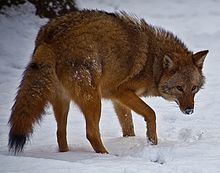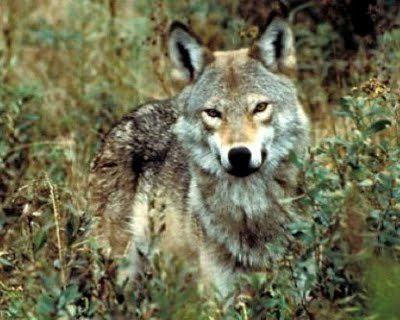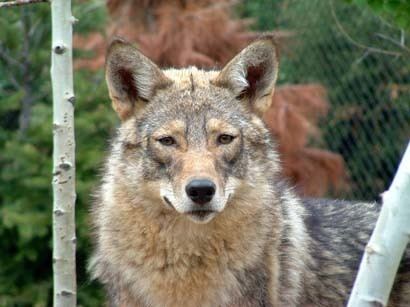Kingdom Animalia Class Mammalia Order Carnivora Rank Hybrid | Phylum Chordata Infraclass Eutheria Family Canidae | |
Scientific name Canis latrans x Canis lycaon Similar Coywolf, Eastern wolf, Coydog, Coyote, Red wolf | ||
Outdoor journal eastern coyote
The Eastern coyote (Canis latrans var.), also known as the Tweed Wolf, is a wild North American canine of mixed coyote-wolf and dog parentage that is present in New England, New York, New Jersey, Pennsylvania, Ohio, West Virginia, Maryland, Delaware and Virginia. They also range in the eastern Canadian provinces of Ontario, Quebec, New Brunswick, Nova Scotia, Prince Edward Island, and Newfoundland and Labrador. It was first noticed during the early 1930s to the late 1940s, and likely originated in the aftermath of the extirpation of the eastern wolf in southeastern Ontario as well as the Labrador wolf in Labrador and Quebec, thus allowing coyotes to colonize the former wolf ranges and mix with the remnant wolf populations. This hybrid is smaller than the eastern wolf and holds smaller territories, but is larger and holds more extensive home ranges than the typical western coyote.
Contents

Taxonomy and Evolution

The canid has been referred to in scientific publications as Canis latrans, Canis latrans var, and Canis latrans × Canis lycaon and has been commonly referred to as the eastern coyote, the northeastern coyote, and the coywolf.

In 2014, a DNA study of northeastern coyotes showed them on average to be a hybrid of western coyote (62%), western wolf (14%), eastern wolf (13%), and domestic dog (11%) in their nuclear genome. The hybrid swarm extended into the midwestern United States, with Ohio coyotes shown on average to be a hybrid of western coyote (66%), western wolf (11%), eastern wolf (12%), and domestic dog (10%) in their nuclear genome. Coyotes and wolves first hybridized in the Great Lakes region, followed by a hybrid coyote expansion that created the largest mammalian hybrid zone known.

For northeastern coyotes, hybridization with the dog was estimated to have occurred between 11 and 24 generations ago, and there is no evidence of recent dog-coyote crossing. There was some evidence of first and second generation wolf-coyote hybrids back-crossing with coyotes. For Ohio coyotes, the wolf DNA was present in the nuclear genome but not the mitochondrial genome, indicating hybridization between male wolves and female coyotes. For northeastern coyotes, the dog DNA was present in the nuclear genome but not the mitochondrial genome, indicating hybridization between male dogs and female coyotes. Although hundreds of northeastern coyotes showed maternal wolf DNA, nearly all were the same haplotype that indicated a past single hybridization between a female wolf and a male coyote. These findings support the hypothesis of sexual interaction based on body size, with the larger species male almost always crossing with the smaller species female.

Northeast coyotes benefit from a more diverse genome that includes genes from both wolves and dogs, which has likely allowed their adaption to both forested and human-dominated habitats. Coyotes moved into the northeast after they began to hybridize with wolves between 154 and 190 years ago. Coyotes are more genetically wolf-like in areas where a high deer density exists, supporting the theory that introgression from wolves allowed genetic adaption to this food source. There are an estimated 16–20 million white-tailed deer in the United States, and their overpopulation is estimated to cause $2 billion in damage each year, with $1 billion in automobile damage alone. Management practices should consider the ecological value of large predators in maintaining their balance.
In 2016, a proposal was made to recognize the eastern coyote as a separate species, Canis oriens (Latin for eastern canid), due to its morphologic and genetic distinctiveness. Additionally, it has bred with other northeast coyotes across the majority of its range, without further hybridization with parent species, except for on the edges of this range. The range includes areas where the western coyote would find it difficult to survive. The designation Canis latrans × Canis lycaon × Canis lupus is unwieldy, with the scientific name of Canis oriens and the common name of coywolf being proposed as an alternative.
Description
Adult eastern coyotes are larger than western coyotes, weighing an average of 14–18 kilograms (30–40 lb), with female eastern coyotes weighing 21% more than male western coyotes. Eastern coyotes also weigh more at birth; while newborn western coyotes weigh 250–300 grams, eastern coyotes weigh 349–360 grams. By the age of 35 days, eastern coyote pups average 1,590 grams, 200 grams more than western coyotes of similar age. After 35 days, physical differences become more apparent, with eastern coyote pups having longer legs than their western counterparts. Differences in dental development have also been observed, with tooth eruption beginning later and in a different order in the eastern coyote. Aside from its size, the eastern and western coyotes are physically similar; both have erect ears, a straight and bushy tail, a conspicuous supracaudal gland and a narrow chest. There are four color phases, ranging from dark brown to blond or reddish blond, though the most common phase is gray-brown, with reddish legs, ears and flanks. There are no significant differences between eastern and western coyotes in expressions of aggression and fighting, though eastern coyotes tend to fight less and are more playful. Unlike western coyote pups, in which fighting precedes play behavior, fighting among eastern coyote pups occurs after the onset of play. Eastern coyotes tend to reach sexual maturity when they reach two years of age, much later than western coyotes.
Food
Eastern coyotes predate a variety of prey including mammals as small as a mouse and as large as moose; however, the Ontario Ministry of Natural Resources lists their main prey items as rabbits, hares, and deer in the winter and small mammals, wild berries, birds, amphibians, and grasshoppers in the summer.
Eastern coyotes are opportunistic omnivores and will prey on whatever is available and easy to scavenge or kill. The diet of the eastern coyote shifts with the changing seasons. Their diet can include, but is not limited to, insects and berries during summer and small mammals in the fall and winter. As winter becomes harder later in the season, larger game such as the white-tailed deer becomes a target for the coyote. Eastern coyotes will often hunt in pairs, and can bring down healthy adult deer. However, deer killed by vehicles or by natural causes are the more frequent target for scavenging. Researchers from the State University of New York College of Environmental Science and Forestry examined animal carcasses visited by radio-collared coyotes during the winter and summer of 2008-09. During the winter, only 8% of adult deer had been killed conclusively by eastern coyotes. The remaining 92% were scavenged by coyotes after being killed by vehicles or after receiving other injuries. The adult deer that were killed by coyotes had severe preexisting injuries, and were likely to die from other causes in the absence of coyote predation. In the spring, the target for the coyote shifts to newborn fawns as they are a much easier prey for the eastern coyote.
